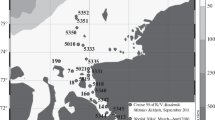Abstract
Rates of bacterial production were measured in the water column, on the surface of plant detritus, and in the surface sediments of a freshwater marsh in the Okefenokee Swamp, Georgia, USA. Bacterioplankton production rates were not correlated with several measures of quantity and quality of dissolved organic matter, including an index of the relative importance of vascular plant derivatives. Bacterioplankton productivity was high (mean: 63 μg C liter−1 day−1) compared with rates reported for other aquatic ecosystems. Somewhat paradoxically, bacterial productivity on plant detritus (mean: 13 μg C g−1 day−1) and sediments (mean: 15 μg C g−1 day−1) was low relative to other locations. On an a real basis, total bacterial productivity in this marsh ecosystem averaged 22 mg C m−2 day−1, based on sample dates in May 1990 and February 1991. Marsh sediments supported the bulk of the production, accounting for 46% (May) and 88% (February) of the total. The remainder was contributed approximately equally by bacteria in the water column and on accumulated stores of plant detritus.
Similar content being viewed by others
References
Aiken GR (1985) Isolation and concentration techniques for aquatic humic substances. In: Aiken GR, McKnight DM, Wershaw RL, MacCarthy P (eds) Humic substances in soil, sediment, and water. Wiley and Sons, New York, pp 363–386
Benner R, Maccubbin AE, Hodson RE (1984) Preparation, characterization, and microbial degradation of specifically radiolabeled [14C]lignocelluloses from marine and freshwater macrophytes. Appl Environ Microbiol 47:381–389
Benner R, Moran MA, Hodson RE (1985) Effects of pH and plant source of lignocellulose biodegradation rates in two wetland ecosystems, the Okefenokee Swamp and a Georgia salt marsh. Limnol Oceanogr 30:489–499
Bjørnsen PK, Kuparinen J (1991) Determination of bacterioplankton biomass, net production and growth efficiency in the Southern Ocean. Mar Ecol Prog Ser 71:185–194
Bratbak G, Dundas I (1984) Bacterial dry matter and biomass estimations. Appl Environ Microbiol 48:755–757
Cole JJ, Findlay S, Pace ML (1988) Bacterial production in fresh and saltwater ecosystems: A cross-system overview. Mar Ecol Prog Ser 43:1–10
Edwards RT, Meyer JL, Findlay SG (1990) The relative contribution of benthic and suspended bacteria to system metabolism in a low-gradient blackwater river. J N Am Benth Soc 9:216–228
Findlay SEG, Arsuffi TL (1989) Microbial growth and detritus transformations during decomposition of leaf litter in a stream. Freshwater Biol 21:261–270
Fry JC (1988) Determination of biomass. In: Austin B (ed) Methods in aquatic bacteriology. John Wiley and Sons, New York, pp 27–72
Greening HS, Gerritsen J (1987) Changes in macrophyte community structure following drought in the Okefenokee Swamp, Georgia, USA. Aquat Bot 28:113–128
Hedges JI, Clark WA, Cowie GL (1988) Organic matter sources to the water column and surficial sediments of a marine bay. Limnol Oceanogr 33:1116–1136
Hobbie JE, Daley RJ, Jasper S (1977) Use of Nuclepore filters for counting bacteria by fluorescence microscopy. Appl Environ Microbiol 33:1225–1228
Kemp PF (1990) The fate of benthic bacterial production. Rev Aquat Sci 2:109–124
Kenworthy WJ, Currin CA, Fonseca MS, Smith G (1989) Production, decomposition, and heterotrophic utilization of the seagrass Halophila decipiens in a submarine canyon. Mar Ecol Prog Ser 51:277–290
Kirchman D, Newell S, Hodson R (1986) Leucine incorporation versus biosynthesis: Implications for measuring rates of protein synthesis and biomass production by bacteria in marine systems. Mar Ecol Prog Ser 32:47–59
Moran MA, Hodson RE (1989a) Bacterial secondary production on vascular plant detritus: Relationships to detritus composition and degradation rate. Appl Environ Microbiol 55:2178–2189
Moran MA, Hodson RE (1989b) Formation and bacterial utilization of dissolved organic carbon derived from detrital lignocellulose. Limnol Oceanogr 34:1034–1047
Moran MA, Hodson RE (1990) Bacterial production on humic and nonhumic components of dissolved organic carbon. Limnol and Oceanogr 35:1744–1756
Moran MA, Wicks RJ, Hodson RE (1991) Export of dissolved organic matter from a mangrove swamp ecosystem: Evidence from natural fluorescence, dissolved lignin phenols, and bacterial secondary production. Mar Ecol Prog Ser 76:175–184
Murray RE, Hodson RE (1985) Annual cycle of bacterial secondary production in five aquatic habitats of the Okefenokee Swamp ecosystem. Appl Environ Microbiol 49:650–655
Murray RE, Hodson RE (1986) Influence of macrophyte decomposition on growth rate and community structure of Okefenokee Swamp bacterioplankton. Appl Environ Microbiol 51:293–301
Newell SY, Fallon RD, Miller JD (1988) Decomposition and microbial dynamics for standing, naturally positioned leaves of a salt-marsh grass. Mar Biol 101:471–481
Riemann B, Bjørnsen PK, Newell S, Fallon R (1987) Calculation of cell production of coastal marine bacteria based on measured incorporation of [3H]thymidine. Limnol Oceanogr 32:471–476
Simon M, Azam F (1989) Protein content and protein synthesis rates of planktonic marine bacteria. Mar Ecol Prog Ser 51:201–213
Thurman EM, Malcolm RL (1983) Structural study of humic substances: New approaches and methods. In: Christman RF, Gjessing ET (eds) Aquatic and terrestrial humic materials. Ann Arbor Science, Ann Arbor, MI, pp 1–23
Wicks RJ, Robarts RD (1987) The extraction and purification of DNA labelled with [methyl-3H]thymidine in aquatic bacterial production studies. J Plank Res 9:1159–1166
Author information
Authors and Affiliations
Additional information
Send offprint requests to: M. A. Moran.
Rights and permissions
About this article
Cite this article
Moran, M.A., Hodson, R.E. Contributions of three subsystems of a freshwater marsh to total bacterial secondary productivity. Microb Ecol 24, 161–170 (1992). https://doi.org/10.1007/BF00174452
Received:
Revised:
Issue Date:
DOI: https://doi.org/10.1007/BF00174452




